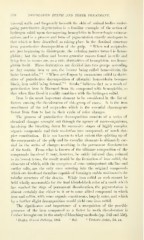Page 540 - My FlipBook
P. 540
5:^S DISCOLORED TEETH AND THEIR TREATMENT.
visceral walls and IVccjiiciitly beneath the skin of animal bodies under-
goiiiii' })ntret;u^tive de42;enei'ati(>n is a I'aniiliar example of" the action ot"
hvdrog'cn snllid npon decomposinjj:; hemot>;lol)in in hemorrhagic extrava-
sations, and is a ])rocess and ibrm of pigmentation exactly analogous to
tl.at wliich is here described as taking place in the dentinal strnctnre
from putrelhctivc decomposition of the pulj). " When red corpuscles
arc just beti'inning to disintegrate, the coloi"ing mtitter formed is hemo-
globin ; but the yellow and brown granidar masses found in cells and
lying free in tissues are, as a rule, derivatives of hemoglobin, not hemo-
globin itself. These derivatives are divided into two groups according
as they contain iron or not, the former being called hemosiderin, the
latter hematoidin." ' " When acted upon by ammonium sulfid (a deriv-
ative of putrefactive decomposition of albumin) hemosiderin becomes
black, iron sultid being formed."^ Grohe'^ believes that as a result of
putrefaction iron is liberated from its compound with hemoglobin, so
that when thus freed it readily combines with the hydrogen snllid.
Iron is the most important element to be considered in the list of
factors causing the discoloration of this group of cases. It is the iron
constituent of the red corpuscles Avhich is the essential chromogenic
factor from first to last in their cycle of color changes.
The process of putrefactive decomposition consists of a series of
chemical changes wrought out through the agency of micro-organisms,
involving the breaking down by successive stages of highly complex
organic compounds and their resolution into compounds of much sim-
pler constitution. It is not known to what extent this splitting up of
the components of the pulp and its vascular elements is ultimately car-
ried in the series of changes resulting in the permanent discoloration
of the tooth. From what is known of the ultimate composition of the
compounds involved it may, howev(>r, be safely inferred that, reduced
to its lowest terms, the result would be the formation of iron sultid, the
elements of which, with the exception of some unimjiortant alkaline and
earthy salts, are the only ones entering into the original compounds
which are fixed and therefore capable of forming a stable residuum in the
tubular structure of the dentin. While iron sulfid as such cannot be
held wholly accountable for the final bluish-black color of a tooth which
has reached the stage of permanent discoloration, the pigmentation is
almost certainly due either to it or to some allied compound in which
iron and sulfur, with some organic constituents, largely enter, and which
by a further slight decomposition would yield true iron sultid.
The significance and importance of a recognition of the possible
))rcsence of the iron compound as a factor in tooth discoloration is
further brought out in the study of bleaching methods (pp. 542 and 558).
' Ziegler, General Putholof/y, 1895. '^ Ibid. ^ Virchow's Archiv., Bd. xx.


